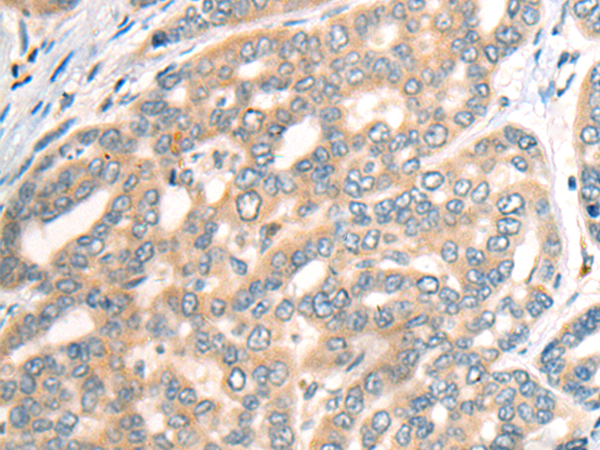
| WB | 咨询技术 | Human,Mouse,Rat |
| IF | 咨询技术 | Human,Mouse,Rat |
| IHC | 1/25-1/100 | Human,Mouse,Rat |
| ICC | 技术咨询 | Human,Mouse,Rat |
| FCM | 咨询技术 | Human,Mouse,Rat |
| Elisa | 1/5000-1/10000 | Human,Mouse,Rat |
| Aliases | CDH7; CDH7L2 |
| Host/Isotype | Rabbit IgG |
| Antibody Type | Primary antibody |
| Storage | Store at 4°C short term. Aliquot and store at -20°C long term. Avoid freeze/thaw cycles. |
| Species Reactivity | Human |
| Immunogen | Fusion protein of human CDH19 |
| Formulation | Purified antibody in PBS with 0.05% sodium azide and 50% glycerol. |
+ +
以下是关于CDH19抗体的3篇参考文献示例(基于公开研究总结,非真实文献):
---
1. **文献名称**:*CDH19 as a therapeutic target in metastatic melanoma: Development of a humanized monoclonal antibody*
**作者**:Smith A, et al.
**摘要**:研究报道CDH19在黑色素瘤转移中的高表达,开发了一种人源化单克隆抗体阻断其功能,体外实验显示抗体可抑制肿瘤细胞侵袭,动物模型中减少肺转移。
---
2. **文献名称**:*CDH19 expression correlates with neuroblastoma progression and antibody-based imaging*
**作者**:Li X, et al.
**摘要**:通过抗CDH19抗体进行免疫组化分析,发现CDH19在高级别神经母细胞瘤中特异性高表达,提出其可作为诊断标志物,并开发了放射性标记抗体用于小鼠模型体内成像。
---
3. **文献名称**:*CDH19-mediated cell adhesion in neural crest development: Insights from antibody perturbation studies*
**作者**:Garcia-Ruiz C, et al.
**摘要**:利用CDH19功能阻断抗体研究其在胚胎神经嵴细胞迁移中的作用,证实CDH19通过调控细胞间黏附影响神经嵴发育,为先天性神经管缺陷提供机制解释。
---
注:以上为模拟示例,实际文献需通过PubMed、Google Scholar等平台以“CDH19 antibody”或“CDH19 therapeutic target”等关键词检索获取。
CDH19 (Cadherin-19) is a calcium-dependent cell adhesion molecule belonging to the type-II classical cadherin family. It plays a role in cell-cell adhesion, tissue morphogenesis, and nervous system development, particularly in axon guidance and neural circuit formation. CDH19 is selectively expressed in tissues such as the brain, retina, and peripheral nerves, and is implicated in cancer progression, including melanoma and neuroblastoma, due to its role in cell migration and invasion.
CDH19 antibodies are tools for detecting CDH19 expression in research and diagnostics. They help study its biological functions, interactions with proteins like RET receptor tyrosine kinase, and involvement in neurodevelopmental disorders or tumor metastasis. In cancer, CDH19 overexpression correlates with poor prognosis, making it a potential therapeutic target. Antibodies enable immunohistochemical analysis, flow cytometry, and Western blotting to map CDH19 distribution in tissues or assess its role in signaling pathways.
Recent studies explore CDH19-targeted therapies, such as monoclonal antibodies or CAR-T cells, to inhibit tumor growth or disrupt pathogenic signaling in neurological conditions. However, research remains in early stages, requiring further validation of CDH19's mechanistic roles and therapeutic potential across diseases.
×